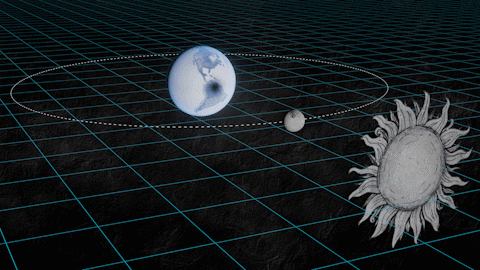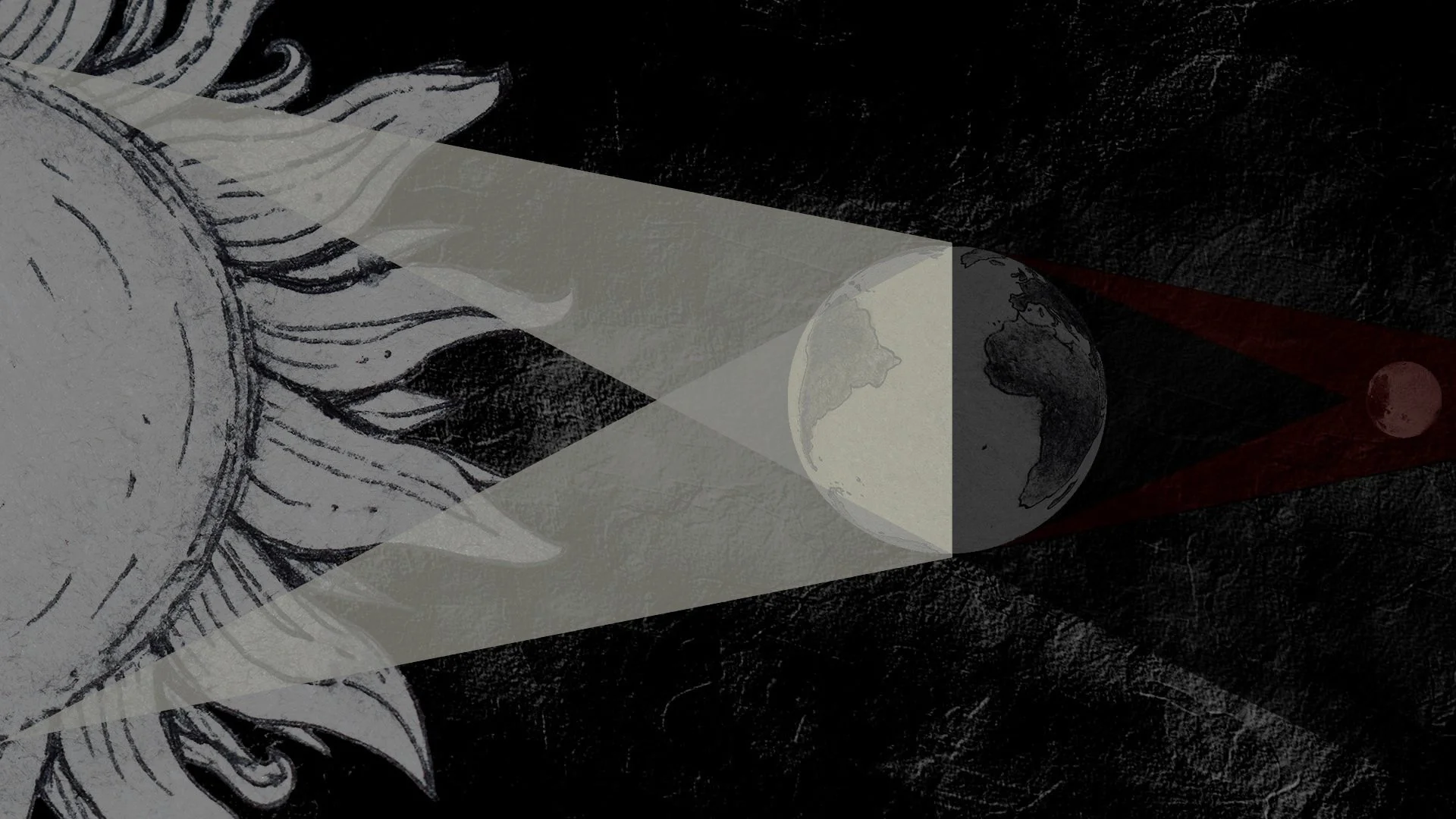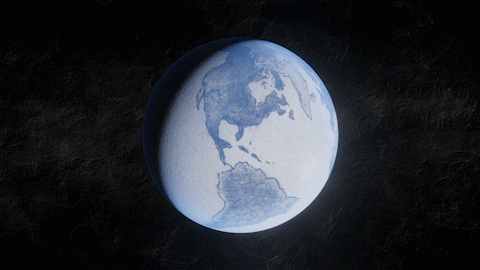About Lunar and Solar Eclipses
Ten Years of Eclipses [Clickable Link]

Path of 2024 Eclipse [World Map] — The dark centre line represents the path where you can see the Moon complete cover the Sun. The expanding grid represents who can see a partial solar eclipse of some degree. The farther you get from the dark centre line, the less coverage you will see.

Total Eclipse Path for Pennsylvania
What is an eclipse?
A lunar eclipse occurs when the Earth is between the Sun and the Moon—so they’re in the order of Sun, Earth, and Moon. This causes the Moon to be darkened by the Earth’s shadow—a lunar eclipse!
A solar eclipse occurs when the Moon is between the Sun and the Earth—so the order is Sun, Moon, and Earth with the Moon casting a shadow on the Earth.
A good way to think about it is: “What’s being eclipsed—what’s being blocked out?” For a lunar eclipse, the Moon is being blocked out by the Earth’s shadow. For a solar eclipse, the Sun is being blocked out by the Moon.
What a lunar eclipse looks like from Earth
For most of the night, for whoever can see the Moon, it will look like any other night. But—because the Moon is constantly orbiting the Earth—the Moon is going to get closer and closer to the outer shadow that the Earth is casting, called the penumbral shadow.
Shadows have different areas to them. Umbra is Latin for shade. In this context, the umbra is the fully shaded (darkest) inner region of a shadow. And pen-, as a prefix, means “almost”. So, penumbra—besides being one of the first horror games I ever played—means “almost shadow”, referring to the lighter, outer part of the shadow.
The reason the Earth’s shadow has these different parts is because the Sun’s light is hitting the Earth from different angles. But there is a conal region of shadow from the middle of the Earth that the Sun’s light doesn’t reach—a darker shadow: an umbra! And this effect isn’t unique to the Earth’s shadow. Look closely at any shadow near you—you’ll see a lighter portion (a penumbra) along the outer portion of the shadow (more so if you pull the object casting the shadow away from the surface the shadow is being cast on)!
Once the Moon enters that penumbral shadow, if you're being extra astute, you'll notice the Moon getting ever-so-slightly dimmer. Then, you'll start to see the Moon go through what looks like its monthly phases. So the Moon's glow—caused by the Sun’s light reflecting off the Moon—will begin to disappear as it moves into the Earth's umbral shadow. It will appear to go from Full Moon to gibbous Moon to quarter Moon to crescent Moon. Then, it will get to a point where there's so little reflected light from the Sun that the darker parts of the Moon will appear to turn red. When the Earth’s umbral shadow completely engulfs the Moon—when there's no more direct sunlight reflecting off the Moon—the entire Moon will appear orange-ish-to-blood-red.
The reason the Moon appears red is because when it’s engulfed in the Earth’s shadow, the only light hitting the Moon is light that has already passed through the Earth’s atmosphere. The light that skims the Earth gets filtered by our atmosphere, and it doesn't come out unscathed. When white light (meaning the light containing all colours) from the Sun goes through the Earth's atmosphere, the cool colours—blue light—get scattered, leaving warm colours to pass through. The cooler the colour, the shorter the wavelength. The shorter the wavelength, the more likely it will interact with atmospheric particles, causing short-wavelength light to be scattered by Earth’s atmosphere and long-wavelength light to more easily pass through. Those warm, long-wavelength colours (red, orange, yellow) reflect off the Moon, making it appear reddish-orange.
As the Moon emerges from the Earth’s shadow, the redness will fade as more and more of the Sun's light hits the Moon once again. It will again appear to go through its monthly phases—crescent, quarter, gibbous. Eventually, it will clear the umbral and penumbral shadow, concluding the lunar eclipse. The process of an ideal total lunar eclipse, from the time the Moon enters the Earth’s penumbral shadow to the time it leaves the penumbral shadow, takes about five hours. But the most stunning part—from when the Moon enters the Earth’s umbral shadow to when it exits the umbral shadow—only lasts about fourteen minutes. So make sure you are prepared by knowing what time (based on your time zone) you need to be on the lookout for an event like this so you don’t miss it!
Because the Earth is about 4 times the size of the Moon—and the current distance of the Moon’s orbit from the Earth—the Earth’s shadow fully encompasses the Moon. So, if you can see the Moon at the time of the eclipse, you will be able to see the eclipse. Not everyone can see the Moon during an eclipse, however. Nor for the entire duration of the eclipse (because it could dip below the horizon). For example, in Florida, the Moon could sink below the horizon before fully entering the Earth’s umbral shadow. But for those in Californian, they would possibly see the Moon both enter and exit the Earth’s umbra (a.k.a. The coolest part of the eclipse).
What a solar eclipse looks like from Earth
A solar eclipse is even more heavily determined by your location relative to the path of totality—the area where you'd have to be to see the Moon directly in front of the Sun. Recall that, at the time of a total lunar eclipse, anyone who can see the Moon can see the lunar eclipse. For solar eclipses, even if you can see the Sun, you may not be able to see the solar eclipse. Only people with the perspective to see the Moon in front of the Sun can see it.
During a solar eclipse, our modestly sized Moon casts its shadow on the comparably larger Earth. Because of this size difference—unlike a lunar eclipse—the Moon’s shadow does not encompass the entire Earth. To see a solar eclipse, you would have to be in the Moon’s umbral shadow (to see a total eclipse) or in the Moon’s penumbral shadow (to see a partial eclipse).
As a solar eclipse unfolds, the Moon is still moving, and the Earth is still rotating. So, the Moon’s shadow appears to trek across the globe, and only people in the path of the shadow will see the Moon in front of the Sun (either partially or totally). The further you are from that path, the less the Sun will appear to be covered by the Moon. If you’re only slightly outside the path of totality, you’ll see only part of the Moon move in front of the Sun (a partial eclipse). If you're far enough away from the path of totality, you won't even know that a solar eclipse is occurring. For instance, the 2021 annular solar eclipse only really went through the Northern part of America, up through Canada, and western Greenland. So, for people down in Africa, the Moon is not in front of the Sun at all for them. Think of it this way: if I'm looking up at a streetlight and there's a fly right in front of my pupil (Ew!) it will block my view of the street light. But my friend next to me can still clearly see the street light. His perspective is, mercifully, far different than mine.
If you're right on the path of totality, you will see the sky darken more and more until the Moon is completely in front of the Sun. From your perspective, the sky will look a much deeper blue. You'll probably even be able to see some brighter stars, and it'll kind of look like Sunset. The further you are away from the path of totality, the brighter the sky remains because the Moon isn’t covering as much of the Sun.
I couldn’t get the shadow on the Earth to be as accurate as I’d have liked it to be, but it’s similar! In-fact, this is a good example of why this shadow doesn’t look like a real solar eclipse shadow. This animation was used in Blender, and I couldn’t figure out how to make the Sun not be a single-point of light. So, it doesn’t really appear to have a penumbra!
This is a representation of an annular solar eclipse. The whole Sun is not covered, so a ring of the Sun’s apparent disk frames the silhouette of Moon.
We’ve talked mainly about total solar eclipses, but there are a few different kinds of solar eclipses. Namely “Total” solar eclipses, and “Annular” solar eclipses. Annular is from the Latin word “annulus”, meaning “ring”. Technically, this solar eclipse doesn't necessarily have a “totality” where the Moon appears to completely block out the Sun, even though the Moon does get directly in front of the Sun. This is due to the shape of our orbits—the path the Moon takes around the Earth, and the path the Earth takes around the Sun. Pretty much all orbits have some amount of eccentricity—some oval-ish-ness—to them. They’re not often perfect circles. In most orbits, there are points where the orbiting object is closer to the thing it's orbiting around, and there are parts where it's further away. This is true for the Moon orbiting the Earth, and the Earth orbiting the Sun. During the 2021 annular solar eclipse—the Moon was far enough away from the Earth that, even though the Moon appeared directly in front of the Sun, it appeared smaller than the Sun in our sky. The Moon didn’t appear to cover the Sun entirely. To the people who had the perspective of the Moon appearing to be right in front of the Sun—the outer edge of the Sun was still visible, appearing like a halo or frame around the Moon.
Viewing a Solar Eclipse
Contrary to what a lot of people say, it is technically safe to look at an eclipse in totality (not so for an annular solar eclipse). The danger is when the Moon moves out of the way just enough, and you're flashed with the Sun's light again. So it's a lot safer to tell people: "Just don't do it; just never do it"—unless you are WELL aware of when the Moon will move from in front of the Sun for a given eclipse. However, you can look at the entirety of an eclipse safely with special glasses—not normal Sunglasses. There are special eclipse glasses that are available for purchase from many reputable sources! They generally block out 90% of light. Slap on these glasses and, whether the Moon covers 1% of the Sun or 100% of the Sun, your eyes will be safe.
There are other ways to safely watch a solar eclipse without glasses. I got sick on the day of the big American eclipse of 2017, so I didn't go to work at the planetarium (where my eclipse glasses were). I stayed home and had to use an alternative way to view the eclipse. I used my phone’s camera! I pointed the camera up at the Sun and snapped some pictures. The camera's compensation of light levels revealed where the Sun was being blocked by the Moon. (Note: I don’t recommend this method if you value your phone’s camera).
I also used a colander. I held the colander close enough to the ground that I saw projections of the Sun on the ground from light passing through the holes. I could see part of the projection missing—that being where the Moon was blocking the Sun’s light. But if you don’t wanna look as silly—holding a colander to the ground—you can click here to learn how to make an “eclipse box” (This is the same principle used for early projectors—a pinhole was poked in the side of a tent and from inside the tent you could see an upside-down projection of what was outside)!
What’s going on out in space when these eclipses happen?
We said that, for Lunar eclipses, the Sun, Earth, and Moon are aligned in that order. That’s why Lunar eclipses only happen during full Moons. When we see a full Moon, it’s because, from our perspective, the Sun is illuminating the Moon straight on. So, for a full Moon to happen, the alignment must be Sun, Earth, Moon—the same alignment for a lunar eclipse. You would never get a lunar eclipse during any other phase besides a full Moon.
Solar eclipses only happen during new Moons—when the Sun, Moon, and Earth are aligned in that order.
Becca's Note: I used to think of New Moons as being whenever there was no Moon in the sky. For the Perseid meteor shower, I hoped for the peak night to occur during a new Moon because the nighttime sky would have no Moon and, therefore, be darker. When James was telling me about these eclipses, I realized that the reason we can’t see the Moon in the nighttime sky during a new Moon is because, during new Moons, the Moon is up during the daytime. This explains why solar eclipses only happen during new Moons: the Sun is only up during the day, so for the Moon to pass in front of the Sun, the Moon also has to be up during the day--a new Moon.
So, with the fact in mind that lunar eclipses only happen during full Moons, and solar eclipses only happen during new Moons—If every month there’s both a full Moon and a new Moon, why is there not a lunar and solar eclipse every month?
The reason that neither lunar nor solar eclipses happen every month, is because the Moon’s orbit around the Earth and the Earth’s orbit around the Sun do not lie on a flat plane. They’re not “level” with one another. There’s about a five-degree difference between them. Now, that may not seem like much, but take a protractor and draw a five-degree angle. Then, extend the lines of that angle outward. You’ll notice the space between the endpoints of your lines is getting farther apart. Now imagine making your lines about 240,000 miles long (the average distance from the Earth to the Moon) -- the end points of those lines are quite far apart!
The blue, or teal, lines in this photo represent the plane of the Earth’s orbit in order to demonstrate the angle at which the moon orbits the Earth relative to how the Earth orbits the Sun.
A representation of how the Moon's orbit appears to change in our sky relative to the Earth's orbit throughout a year.
However, there are points where the Moon’s orbit intersects the orbital plane of the Earth and Sun (gets directly between the Earth and Sun). These points are called “nodes.” These are when eclipses can happen. Though, not all nodes will result in an eclipse. The Earth, Moon, and Sun won’t always be lined up at the time the Moon passes through a node.
Furthermore, solar eclipses happen more often than most people realize, but because the shadow cast by the eclipse is small and the Earth’s surface is mostly water, most of the time the shadow is cast on the ocean.
But you’d be surprised how far people will go for a solar eclipse!
Note from the Author
I want to encourage you to ask questions.
If something doesn’t make sense, or something I say makes you wonder about this or that, don’t hesitate -- submit a question from our contact page.
When I was in school, I always felt like asking questions was stigmatised. I felt like I should know the answer already or that I’d be judged in some way. And from my perspective, my main goal with Fly Science is to help people not feel that way. Because if someone is judged for asking questions, the implication is that there’s something wrong with them -- the way they are isn’t accepted or enough. And golly, if the stakes feel that high, then yeah, it makes sense people would be hesitant to speak up. But those should never be the stakes, and it’s certainly not the stakes here. So help us set that precedent -- ask your questions. And if we don’t know the answer right off the bat, we’ll do some research and get back to you.
ACKNOWLEDGEMENTS
If you’ve watched past streams in addition to the 2021 eclipse show, you may have noticed that the graphics of this show drastically improved in quality. We have two friends to thank: Rachel Dressler and Trevor Cassel. Rachel is an amazing artist—talented, and creative. I’m always in awe at the “doodles” she’ll whip out in half an hour when she’s bored—doodles I’d expect to see for sale for hundreds at a hipster coffee shop/art gallery in a renovated warehouse hidden in the heart of a big city. One time, after she sent me some pictures of her artwork, I had a brain blast: her art could elevate these shows to a whole new level. I proposed, and she said yes (to doing some artwork for Fly Science). NOT ONLY did she draw the Earth, Moon, and Sun used in this show, she even made the paper (out of recycled cardboard egg cartons) on which she drew. Show Rachel some love by checking out the video showing her making this paper. At the end, you’ll even see her original drawing of the Sun used in the 2021 eclipse show!
As for making it 3D, as well as lots of troubleshooting all our animations, I want to thank Trevor. To make these animations, I had to learn to use a program that was mostly new to me. Trevor has been my teacher and go-to person for those “I-broke-everything-Everything-is-ruined-There’s-no-hope-I-should-just-crawl-under-a-rock-and-stay-there” moments. He’s been helpful, patient, understanding, and an invaluable resource. Without Trevor, these animations would have been lower quality and a lot more of a headache to do. And to brag a bit on his behalf (since he’s too humble to acknowledge how impressive this is) his coding and programming knowledge is mostly self-taught. His approach to continuous learning is truly inspirational.










